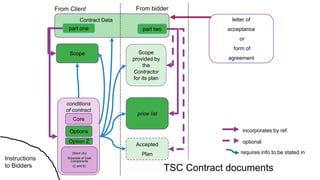INTRODUCTION
In the construction contracts, procurement is considered as a procedure through which the owner of the project gets services of suppliers, consultants and contractors to perform a project of construction. The procurement method plays crucial role in identifying the responsibilities, relationship and roles of the parties in the construction contract. The procurement influences the timeline and cost of the project, risk allocation and also impact the overall process of the delivery of the project (Furst et al., 2012). In the construction contracts, there are different kinds of procurement methods which are suited to various kinds of projects, goals of projects and requirements of the clients. Such methods of procurements are collaborative and traditional approach and both the approaches have their own benefits, contract arrangements and risk. This report will discuss about three different scenarios in the context of these two methods of procurement. It will also discuss about different remedies available for the client according to the type of contract.

Figure 1: Construction industry
MAIN BODY
In the construction contract, there are two different kinds of procurement methods which are collaborative and traditional methods.
JCT (with Quantities)
Traditional or JCT contracts is also considered as Design-Bid-Build. It is one of the common method of procurements in which the stage of construction and design are separate from each other (Bunni, 2003). In this method, the owner of the project appoints an engineer or architect for completion of designing before giving a tender to the contractors.
Benefits of Traditional Methods are:
- It clearly allocates the responsibilities of the engineers and designers (Ogunlana and Dey, 2019).
- Mainly, this method of procurement employed for the construction projects in which there is need of certain design before starting construction.
NEC4 (option A)
Collaboration or NEC4 contract is considered as a Design and Build where the construction and designs are managed by one single person or contractor who offers construction services as well as design.
Benefits of collaboration methods are:
- This approach helps in saving time to perform a contract.
- It streamlining a communication among the construction and design team.
In the contracts of construction, the selection of type of contract: collaborative and traditional can impact the management of the occurrence of different events (Limited, 2007). Along with this, the choice also impacts the available remedies for the parties in the construction project.

Figure 2: NEC contracts
Scenario1: Due to some unforeseen conditions and need to comply with the recent regulations of buildings, a significant design convert to foundation design.
JCT (with Quantities)
- Kind of remedy: In the traditional methods of procurement, the construction contract works as per the designs which are provided by the design team of the employer or employer (Chappell, 2010). If there is an occurrence of unforeseen events then it can lead in changes but the construction contractor may have a right to extend the time of project completion and also provided with extra compensation for the extra work which is required due to the unforeseen events.
- Entitlements:
- Extra costing:Under this method, contractor may have a right to get additional cost for additional work under clause 2 due to the occurrence of variations by providing a proof of additional cost and also comply with the procedure of contract for the changes (Anon, 2017).
- Time extension: In the construction projects, contractors have a right to claim compensation for the time extension because of the occurrence of unforeseen events.
- Solution of Disputes: If in the contract, parties are disagreed on cost or impact of the modifications then they may require to adopt mechanism of dispute resolution like arbitration or adjudication (Osipova and Eriksson, 2021).
NEC4 Option A
- Kind of Remedy: In the collaborative approach, parties work with each other to identify solution with the mutual consent (Pate and Scullion, 2009). In the condition of occurrence of unforeseen condition, collaborative method encourage early evaluation of the issues and transparent communication along with this it also emphasizes on minimize the impact of such events.
- Entitlement:
- Distribution of rewards and risk: In the construction, the team may distribute the risk related to the time extension and cost enhancement (Murdoch and Hughes, 2019). If the cost of the construction is enhanced dur to unforeseen events, then the cost may be distributed between contractor and client.
- Collective solution of problem: The whole construction team can find solution collectively to diminish the time and cost of project completion which also helps in reducing the requirement of dispute resolution mechanism.
- Adjustments in the budget and schedule of project: This type of approach allows adjustments related to the budget and schedule which ensues minimal disruption of the project.
Comparison
JCT provides a rigid approach for managing the changes in design that may leads in delay because of the formal process. NEC4 offers cooperative and flexible method which foster quick resolution of the dispute.
Scenario 2: Construction Site closure for 3 works because of adverse conditions of weather
JCT (with Quantities)
- Kind of Remedy:The construction contractors are responsible typically for the work completion in the traditional contracts within the time limit (Loosemore and McCarthy, 2007). The adverse conditions of the weather which leads in delay in work could be considered as a force majeure event. This situation would permit contractors to request parties for the time extension under clause 2.28 but they may not claim compensation for the additional cost unless the adverse weather cause direct additional cost.
- Entitlements
- Not allowing compensation for the delay: Under the traditional procurement contracts, Contractor is not entitled for the compensation due to delay in construction unless there is certain specific terms mention into the contract (Jervis and Levin, 1988). But the contract has a right to claim compensation for the incurred additional cost due to the weather.
- Time Extension: In the traditional contracts, contractor in the construction project would be allowed to time extension for delay duration if there is any provision related to the occurrence of delay due to the force majeure event within the contract (Gordon, 1994).
- Solution of conflict: The dispute related to whether the delay in time is excusable or whether the occurrence of event is considered as a force majeure event, such conflict may be solved by using the mechanism of dispute resolution.
NEC4 Option A
- Kind of Remedy: Under the collaborative approach, the delay due to weather is also considered as a risk which could impact the timeline of the project completion (Anon, 2008). In the collaborative contracts, both the parties are work with each other and identify the mutually accepted solution which helps eliminating delay and its impact.
- Entitlement:
- Collective efforts for mitigation: In the collaborative procurement approach, all parties may identify the solution to mitigate the delay like shifting the site to the different area which is not severely affected by the unforeseen weather.
- Flexible adjustments in the schedule:In the contracts, team may become flexible related to the adjustment in schedule without any time extension under clause 60.1 (Bert, 2005). The emphasize is on reducing the impact of the delay and rescheduling tasks.
- Distribution of responsibilities for the impact of costs:The collaborative approach includes sharing of risk between the client as well as contractor which may occur in the form of extra cost because of the delay (Finnie, Ameer Ali and Park, 2021). The main concentration is on maintaining the progress of the project.
Comparison
JCT provides very formalised and very less flexible method to delay related to weather sue to which contractor may face additional cost NEC4 offers a collaborative and dynamic solution along with the proactive compensation events and early warnings.

Figure 3: Construction contracts
Scenario 3: Important deformation of the retaining wall because of the failure of formwork section.
JCT (with Quantities)
- Kind of Remedy: In the traditional approach of contract, contractors are liable for the quality maintenance of work and also for the performance of formwork and materials under clause 2.2 (Shiers, Lavers and Keeping, 2007). If in the construction contract, formwork fails and leads in deformation, it is considered as a fault of contractor and only contractor is responsible to fix such defect at any cost.
- Entitlement
- Time extension and delay: If the work of rectification leads in delay them the contractor in the construction may request for the time extension for the delay but contractor would not entitle to get compensation for the occurrence of extra cost unless the extra cost occur to the unforeseen event (Cheung and Yiu, 2006).
- Rectification:Under the traditional approach, contractor will need to rectify overall defects at any cost.
- Solving disputes:The employer and contractor bothy need to adopt the mechanism of disputed resolution for solving their dispute which may caused to due to the failure of formwork.
NEC4 Option A
- Kind of Remedy: Under the collaborative approach, team of the construction project would perform activities with each other to find out the cause of the failure of formwork that may include discussion related to the material, method of construction and design(Chern, 2016). If the formwork failure was caused because of the design error or bad workmanship then the concentration would be on identifying the collective solutions.
- Entitlement:
- Flexible adjustments of schedule: Ifthere is an occurrence of delay because of the rectification, this approach would permit for the adjustment of the schedule with the very less formal way of time extension clause. Both the parties are likely to collectively identify how to reduce or manage delay.
- Collective rectification: The contractor and employer both would jointly rectify the problems and also share the extra cost which occur at the time of rectification (Zaghloul and Hartman, 2003).
- Cost sharing: The cost occurred due to the failure like the rectification cost, damage cost which is caused because of the delays and many more, all may be distributed among the parties in the construction team.
Comparison
JCT is not much flexible in context of managing defects and also place responsibility on contractor which could leads in formal processes of dispute solution. NEC4 encourage early warning and collaboration that can expedite defect resolution in the easy way.
Overall summary of both the approaches offered by JCT and NEC4
Traditional contract: In the traditional approach, parties run their functions in very adversarial way along with the allocation of responsibilities and procedures of the formal claims (Winch, 2002). In the construction, contractor is likely to bear the cost related to the defects and delays and also the remedies like time extension, changes and the mechanism of dispute resolution which are employed for manage unforeseen events.
Collaborative procurement contracts: In this contract, the main concentration is on the collective sharing of risk and problem solving along with the clear communication and flexibility among the parties in the construction contracts. Along with this, the focus is also on the joint responsibility or liability for the results which includes unforeseen conditions, defects and delay (La Porta, Lopez-De-Silanes and Shleifer, 2008). The remedies can be negotiated or shared on the basis of nature of case which foster cooperation among the parties rather than a dispute.
Therefore, In the collaborative and traditional approach, there is a main difference in their way of management of delays, additional costs and disputes. The traditional approach is little bit more structured and rigid approach whereas the collaborative approach focuses on maintaining collaborative or cooperation, shared risk and flexibility which helps in mitigating the risk in easy manner.
CONCLUSION
This report has concluded that the NEC4 Option A and JCT contracts both are varied approaches for managing the issues raised at the construction sites. JCT contracts are very rigid and structured approaches which focus on formal processes and mechanism of dispute resolution whereas NEC4 contracts are very flexible approach. This report has concluded that in the cases of adverse weather, defect and deign changes, JCT contracts depend on formal procedure whereas NEC4 depend on collaborative solution. Ultimately, the selection of the contract is depended on the project dynamics.
REFERENCES
Books and Journals
Books
- Anon (2017) JCT Contracts Discovery: The Education and Learning Module from the Joint Contracts Tribunal.
- Bunni, N. G. (2003) Risk and Insurance in Construction, Routledge.
- Chappell, D. (2010) Construction Contracts: Questions and Answers, Routledge
- Furst, S., Ramsey, V., Hannaford, S., Williamson, A., Keating, D. and Uff, J. (2012) Keating on Construction Contracts, Sweet & Maxwell.
- Limited, T. T. (2007) Construction Law Handbook, Thomas Telford.
- Ogunlana, S. and Dey, P. K. (2019) Risk Management in Engineering and Construction: Tools and Techniques, Routledge.
Journals
- Anon (2008) Contracts: JCT and NEC, In Routledge eBooks, pp. 82–88, [online] Available at: https://doi.org/10.4324/9780203938096-20.
- Bert, R. (2005) Book Review: Smith, Currie & Hancock’s Common Sense Construction Law, Third Edition , edited by Thomas J. Kelleher, Jr. Hoboken, New Jersey: John Wiley & Sons, Inc., 2005, Civil Engineering, 75(7), p. 66, [online] Available at: https://cedb.asce.org/CEDBsearch/record.jsp?dockey=0149794.
- Chern, C. (2016) The Law of Construction Disputes, Routledge eBooks, [online] Available at: https://doi.org/10.4324/9781315692555.
- Cheung, S. O. and Yiu, T. W. (2006) Are Construction Disputes Inevitable?, IEEE Transactions on Engineering Management, 53(3), pp. 456–470, [online] Available at: https://doi.org/10.1109/tem.2006.877445.
- Gordon, C. M. (1994) Choosing Appropriate Construction Contracting Method, Journal of Construction Engineering and Management, 120(1), pp. 196–210, [online] Available at: https://doi.org/10.1061/(asce)0733-9364(1994)120:1(196).
- Jervis, B. M. and Levin, P. (1988) Construction law, principles and practice, [online] Available at: http://ci.nii.ac.jp/ncid/BA22800900.
- La Porta, R., Lopez-De-Silanes, F. and Shleifer, A. (2008) The Economic Consequences of Legal Origins, Journal of Economic Literature, 46(2), pp. 285–332, [online] Available at: https://doi.org/10.1257/jel.46.2.285.
- Loosemore, M. and McCarthy, C. S. (2007) Perceptions of Contractual Risk Allocation in Construction Supply Chains, Journal of Professional Issues in Engineering Education and Practice, 134(1), pp. 95–105, [online] Available at: https://doi.org/10.1061/(asce)1052-3928(2008)134:1(95).
- Murdoch, J. R. and Hughes, W. (2019) Construction Contracts : Law And Management, 5Th Edition, [online] Available at: https://centaur.reading.ac.uk/62769/.
- Osipova, E. and Eriksson, P. E. (2011) How procurement options influence risk management in construction projects, Construction Management and Economics, 29(11), pp. 1149–1158, [online] Available at: https://doi.org/10.1080/01446193.2011.639379.
- Pate, J. and Scullion, H. (2009) The changing nature of the traditional expatriate psychological contract, Employee Relations, 32(1), pp. 56–73, [online] Available at: https://doi.org/10.1108/01425451011002761.
- Shiers, D., Lavers, A. and Keeping, M. (2007) Indicators of the impact of environmental factors on UK construction law: developments in the new millennium, Construction Management and Economics, 25(7), pp. 821–829, [online] Available at: https://doi.org/10.1080/01446190601145278.
- Winch, G. M. (2002) Managing Construction Projects: An Information Processing Approach, [online] Available at: https://ci.nii.ac.jp/ncid/BB00549998.
- Zaghloul, R. and Hartman, F. (2003) Construction contracts: the cost of mistrust, International Journal of Project Management, 21(6), pp. 419–424, [online] Available at: https://doi.org/10.1016/s0263-7863(02)00082-0.
Table of figures
- Figure1: Construction industry, 2023 is online available at :< https://www.autodesk.com/blogs/construction/construction-sites-types-safety-tips/>
- Figure2: NEC contracts, 2024 is online available at :< https://www.slideshare.net/slideshow/nec-term-service-contract-tsc/253743978>
- Construction Contract, 2023 is online available at :< https://www.providentprotectionplus.com/5-features-every-construction-contract-should-include/>



















